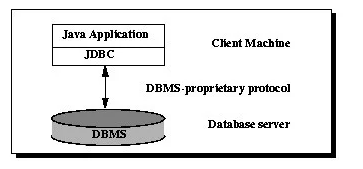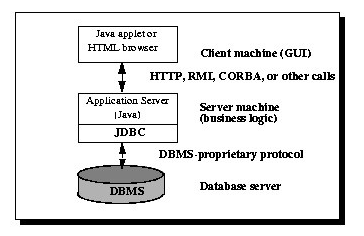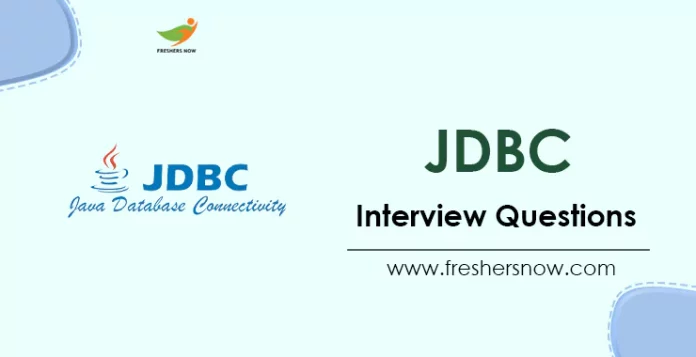
JDBC Interview Questions and Answers: JDBC is a Java API for interacting with databases and executing SQL queries. It uses drivers to connect with different database systems. With JDBC, developers can access tabular data stored in relational databases like Oracle, MySQL, MS Access, and more. To excel in the Latest JDBC Interview Questions, it is essential to have a strong understanding of the technology and its functionalities. This article provides a compilation of the Top 50 JDBC Interview Questions and Answers, which can greatly aid in gaining a deeper comprehension of the JDBC Technical Interview Questions.
★★ Latest Technical Interview Questions ★★
JDBC Technical Interview Questions
This collection of Top 50 JDBC Interview Questions and Answers encompasses both technical and JDBC Interview Questions for Freshers. Going through these questions will enhance your understanding and improve your chances of excelling in a JDBC interview.
Top 50 JDBC Interview Questions and Answers
1. What is JDBC and what is its significance in Java programming?
JDBC (Java Database Connectivity) is an API in Java that allows Java programs to interact with databases. It provides a standard way to connect to a database, execute SQL queries, and retrieve results. JDBC plays a crucial role in Java programming as it enables seamless integration with various database systems, allowing developers to store, retrieve, and manipulate data efficiently.
2. What is JDBC in Java?
JDBC, short for Java Database Connectivity, is a Java API that facilitates interaction with databases for data retrieval, manipulation, and processing using SQL queries. It utilizes JDBC drivers to establish connections with databases. With JDBC, developers can access tabular data stored in different relational databases like Oracle, MySQL, and MS Access.
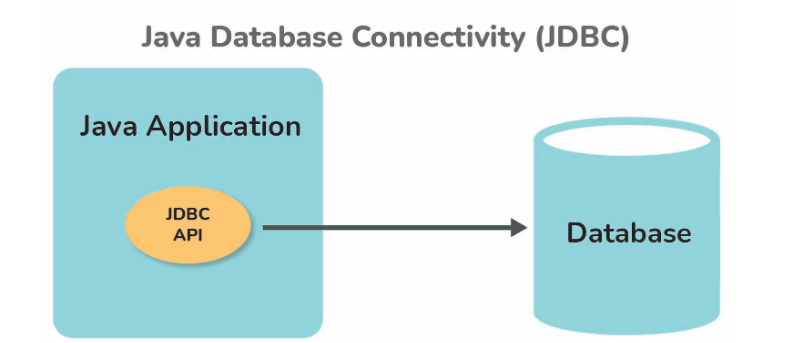
3. Explain the architecture of JDBC.
The architecture of JDBC consists of multiple components.
- JDBC API: It provides interfaces and classes for database programming, including classes for connection, statement, result set, and metadata.
- JDBC Driver Manager: It manages the drivers for database connectivity. It is responsible for loading the appropriate driver and establishing the connection between the Java application and the database.
- JDBC Drivers: These are the implementation-specific drivers that enable communication between the Java application and the database server. There are four types of JDBC drivers: Type 1 (JDBC-ODBC bridge driver), Type 2 (Native-API/partly Java driver), Type 3 (Network Protocol driver), and Type 4 (Native-Protocol pure Java driver).
4. Explain the JDBC Architecture?
JDBC API supports both 2-tier and 3-tier models for the database.
In a 2-tier model, the Java application interacts with the data source
In the 3-tier model, commands are redirected to a “middle tier” of services. After that commands are sent to the data source.
5. What are the different types of JDBC drivers?
There are four types of JDBC drivers:
- Type 1 (JDBC-ODBC bridge driver): This driver uses the ODBC (Open Database Connectivity) API to connect to the database. It requires the ODBC driver to be installed on the client’s machine.
- Type 2 (Native-API/partly Java driver): This driver uses the database-specific client library to connect to the database. It provides better performance than the Type 1 driver but requires the database client library to be installed on the client machine.
- Type 3 (Network Protocol driver): This driver uses a middle-tier server to communicate with the database. It converts JDBC calls into a database-specific protocol and then sends them to the server, which communicates with the database.
- Type 4 (Native-Protocol pure Java driver): This driver is implemented purely in Java and communicates directly with the database using the database’s native protocol. It offers the best performance and does not require any external libraries.
6. What are the isolation levels of connections in JDBC?
- A transaction isolation level determines the degree of isolation between transactions in terms of data consistency.
- Higher isolation levels ensure better data accuracy but may limit the number of concurrent transactions.
- Lower isolation levels allow more concurrent transactions but may compromise data accuracy.
- DBMS uses locks to prevent simultaneous access to data involved in a transaction, ensuring data integrity.
- Locking mechanisms are employed by the DBMS to prevent issues like Dirty Read, Non-Repeatable Read, and Phantom-Read.
- JDBC provides methods like setTransactionIsolation() and getTransactionIsolation() to set and retrieve the transaction isolation level, respectively.
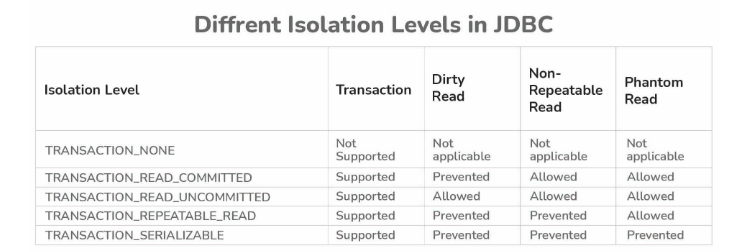
7. How do you establish a connection with a database using JDBC?
To establish a connection with a database using JDBC, you need to follow these steps:
- Load the appropriate JDBC driver class using
Class.forName(), which dynamically loads the driver class into memory. - Create a connection URL that specifies the database’s location, name, credentials and any additional parameters required.
- Use the
DriverManager.getConnection()method, passing the connection URL and optional username and password parameters, to establish the connection to the database. - Once the connection is established, you can create and execute SQL statements using the connection object.
8. What is a Statement in JDBC?
In JDBC, a Statement is an interface that represents a SQL statement that is sent to the database for execution. It is used to execute static SQL queries and updates. The Statement interface provides various methods to execute SQL statements, retrieve query results, and manage resources.
9. Differentiate between Statement and PreparedStatement in JDBC.
The main differences between Statement and PreparedStatement in JDBC are as follows:
- Statement: It is used to execute static SQL queries and updates. The SQL statement is directly embedded in the Java code as a string. The SQL statement is compiled and executed each time it is executed, which can result in performance overhead.
- PreparedStatement: It is a subclass of statements and is used to execute parameterized SQL queries and updates. The SQL statement is precompiled and stored in a PreparedStatement object. It allows you to set parameters in the SQL statement using placeholders, which provides better performance and security. PreparedStatement is suitable for executing the same SQL statement multiple times with different parameter values.
10. What is “Dirty read” in terms of the database?
- Dirty reading refers to reading a value that may be incorrect or uncommitted.
- It occurs when one transaction reads a field value that is being modified by another transaction before it is committed.
- This can lead to inconsistent or invalid data if the modifying transaction rolls back or updates the data after it has been read.
- It can result in misleading or erroneous data views in the context of other transactions.
- For example, if Transaction 2 modifies a row but doesn’t commit, and Transaction 1 reads the uncommitted data, the view of the data may be incorrect.
- In some cases, it may show data that does not actually exist in the database.
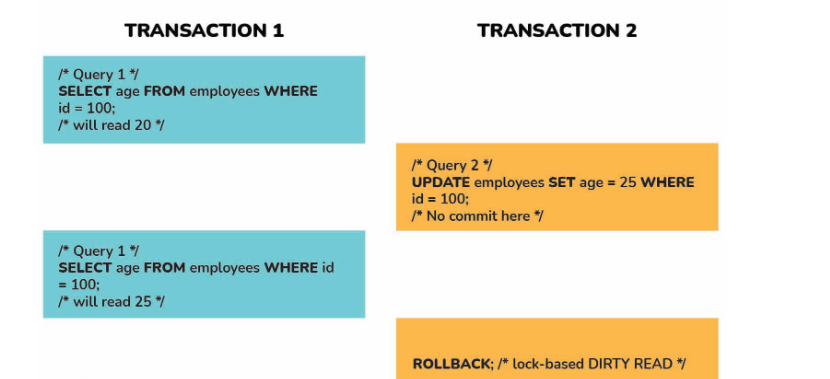
11. How do you handle database transactions in JDBC?
JDBC provides support for managing database transactions through the Connection interface. To handle database transactions in JDBC, you can follow these steps:
- Disable auto-commit mode on the connection by invoking
connection.setAutoCommit(false). - Begin the transaction by executing the required SQL statements.
- If all statements execute successfully, commit the transaction using
connection.commit(). - If any statement fails, roll back the transaction using
connection.rollback(). - Enable auto-commit mode again using
connection.setAutoCommit(true).
12. What is a ResultSet in JDBC?
A ResultSet in JDBC is an interface that represents the result of a database query. It holds the data returned by a SELECT statement and provides methods to retrieve and manipulate that data. The ResultSet object acts as a cursor that allows you to navigate through the query results row by row.
13. Explain the different types of ResultSet concurrency.
JDBC supports three types of ResultSet concurrency:
- ResultSet.CONCUR_READ_ONLY: Indicates that the ResultSet object is read-only, and any attempt to modify the data will result in an exception.
- ResultSet.CONCUR_UPDATABLE: Indicates that the ResultSet object is updatable, and you can modify the data in the ResultSet and subsequently update the corresponding database rows.
- ResultSet.CONCUR_READ_ONLY and ResultSet.CONCUR_UPDATABLE are the two constants defined in the ResultSet interface.
14. How do you retrieve data from a ResultSet in JDBC?
To retrieve data from a ResultSet in JDBC, you can use various methods provided by the ResultSet interface. Some commonly used methods include:
next(): Moves the cursor to the next row in the ResultSet.getInt(int columnIndex)orgetInt(String columnLabel): Retrieves the value of the specified column as an int.getString(int columnIndex)orgetString(String columnLabel): Retrieves the value of the specified column as a String.getBoolean(int columnIndex)orgetBoolean(String columnLabel): Retrieves the value of the specified column as a boolean.getDate(int columnIndex)orgetDate(String columnLabel): Retrieves the value of the specified column as a java.sql.Date.
15. What is the purpose of the JDBC savepoint?
The JDBC savepoint allows you to create a point within a transaction where you can roll back if necessary. It provides a way to divide a transaction into multiple logical parts and selectively roll back to a specific savepoint, rather than rolling back the entire transaction.
16. Explain the steps involved in executing a stored procedure using JDBC.
To execute a stored procedure using JDBC, you can follow these steps:
- Create a CallableStatement using the connection’s
prepareCall()method and provide the SQL statement that invokes the stored procedure. - Set any input parameters using the
setXXX()methods of the CallableStatement. - Register output parameters using the
registerOutParameter()method. - Execute the stored procedure using the
execute()method. - Retrieve the output values using the
getXXX()methods of the CallableStatement.
17. How do you handle exceptions in JDBC?
JDBC uses the standard exception-handling mechanism in Java. To handle exceptions in JDBC, you can use try-catch blocks to catch specific exceptions that may occur during database operations, such as SQLException. Additionally, you can also handle exceptions related to resource management, such as closing connections, statements, or result sets, in a final block to ensure proper cleanup.
18. What is connection pooling in JDBC and why is it important?
Connection pooling in JDBC involves reusing existing database connections instead of creating a new connection for each request. It is important because it improves the performance and scalability of the application by reducing the overhead of establishing a new database connection for each user request. Connection pooling allows multiple requests to share a set of reusable connections, leading to better utilization of resources and improved response times.
19. Explain the role of the DriverManager class in JDBC.
The DriverManager class in JDBC acts as a central component for managing JDBC drivers. It is responsible for loading the appropriate driver implementation based on the connection URL provided. The DriverManager class provides methods to register and deregister drivers, and it handles the task of establishing and managing connections to the database.
20. How can you retrieve metadata from a database using JDBC?
You can retrieve metadata from a database using JDBC by using the DatabaseMetaData interface. The DatabaseMetaData interface provides methods to obtain information about the database, such as its tables, columns, primary keys, foreign keys, and supported features. You can obtain a DatabaseMetaData object by calling the getMetaData() method on the Connection object.
21. What are batch updates in JDBC and how do they work?
Batch updates in JDBC allow you to group multiple SQL statements together and send them to the database server as a batch. Instead of executing each statement individually, the database processes them together, resulting in improved performance. You can use the addBatch() method to add SQL statements to the batch, and then execute them using the executeBatch() method.
22. Explain the concept of scrollable ResultSets in JDBC.
Scrollable ResultSets in JDBC allows you to navigate through the rows of a ResultSet in both forward and backward directions. It provides methods such as absolute(), relative(), and first() to move the cursor to a specific position in the ResultSet. Scrollable ResultSets provide more flexibility in accessing data and are useful for tasks like pagination and random access to result set rows.
23. How do you retrieve auto-generated keys in JDBC?
To retrieve auto-generated keys in JDBC, you can use the executeUpdate() method that accepts an additional flag to specify that you want to retrieve the generated keys. After executing the update statement, you can obtain the generated keys using the getGeneratedKeys() method of the Statement or PreparedStatement object.
24. What is the purpose of the DatabaseMetaData interface in JDBC?
The DatabaseMetaData interface in JDBC provides methods to retrieve metadata about the database, such as its capabilities, supported features, table information, and more. It allows you to obtain information about the database’s structure, schema, indexes, and other database-specific details. The DatabaseMetaData interface is useful for building dynamic and generic database applications.
25. How does the executeQuery() method differ from the executeUpdate() method in JDBC?
| executeQuery() | executeUpdate() |
|---|---|
| Used for executing SELECT statements and retrieving a ResultSet. | Used for executing INSERT, UPDATE, DELETE, or DDL statements and returns an update count. |
| Returns a ResultSet object that contains the query results. | Returns an integer value representing the number of affected rows by the executed statement. |
| Used for retrieving data from the database. | Used for modifying data in the database. |
| Does not require manual closing of the ResultSet. | Requires manual closing of the ResultSet using the close() method. |
26. What is the purpose of the ResultSetMetaData interface in JDBC?
The ResultSetMetaData interface in JDBC provides methods to retrieve metadata about the columns of a ResultSet, such as column names, data types, column sizes, and more. It allows you to dynamically retrieve information about the result set’s structure, which is especially useful when working with result sets of unknown or dynamically changing structures.
27. How can you handle large binary data (BLOB) using JDBC?
To handle large binary data (BLOB) using JDBC, you can use the JDBC API’s support for BLOBs. You can create a BLOB object using the Connection object’s createBlob() method and set the BLOB data using streams or byte arrays. You can then insert or update the BLOB column using the PreparedStatement’s setBlob() method.
28. Explain the concept of connection pooling in JDBC.
Connection pooling in JDBC involves reusing existing database connections instead of creating a new connection for each request. Connection pooling improves performance by reducing the overhead of establishing a new database connection. A connection pool manages a set of pre-initialized connections, and when a connection is needed, it is borrowed from the pool. After use, the connection is returned to the pool for reuse.
29. What are the advantages of using PreparedStatement over Statement in JDBC?
PreparedStatement offers several advantages over Statement in JDBC:
- Performance: Prepared statements are precompiled, which allows the database to optimize the query execution plan. This can result in improved performance, especially when executing the same SQL statement multiple times.
- Security: PreparedStatements help prevent SQL injection attacks by automatically escaping input parameters.
- Code readability: PreparedStatements provide placeholders for parameters, making the code more readable and maintainable.
- Parameterized queries: PreparedStatements allow the reuse of the same SQL statement with different parameter values.
30. What is the difference between a ResultSet and a CachedRowSet in JDBC?
| ResultSet | CachedRowSet |
|---|---|
| Represents a set of rows retrieved from a database query. | Implements the ResultSet interface and extends it to provide additional functionality. |
| Requires an open connection to the database to navigate and retrieve data. | Can operate in a disconnected mode and does not require an open connection after retrieval. |
| Provides live data that reflects changes made to the database during the ResultSet’s lifetime. | Retrieves a snapshot of the data at the time of creation and is not affected by subsequent changes. |
| Cannot be directly serialized or transferred across different layers or applications. | Can be serialized, allowing easy transfer of data across layers or applications. |
31. How do you handle transactions in JDBC?
Transactions in JDBC can be handled using the Connection object. You can disable auto-commit mode by invoking connection.setAutoCommit(false) and beginning a transaction. After executing the necessary SQL statements, you can commit the transaction using connection.commit(). If an error occurs or you need to roll back, you can call connection.rollback() to undo the changes made within the transaction.
32. How do you handle database errors and exceptions in JDBC?
In JDBC, you can handle database errors and exceptions using try-catch blocks. The SQLException class represents database-related exceptions. You can catch SQLException and handle different types of exceptions, such as connection errors, statement errors, or result set errors. It is recommended to log the exception details and handle them appropriately based on the requirements of your application.
33. What is the syntax for closing a JDBC connection and other related resources in Java?
To close a JDBC connection and other related resources in Java, you need to follow this syntax:
try {
// JDBC operations
} finally {
if (resultSet != null) {
resultSet.close();
}
if (statement != null) {
statement.close();
}
if (connection != null) {
connection.close();
}
}</pre?
34. Explain the concept of metadata caching in JDBC.
Metadata caching in JDBC refers to the mechanism of storing and reusing metadata information retrieved from the database. When you query metadata using methods like getTables(), getColumnNames(), etc., JDBC retrieves the metadata information from the database. To improve performance, JDBC can cache this metadata information so that subsequent calls to the same metadata-related methods can be served from the cache instead of hitting the database again.
35. What is the difference between Statement and PreparedStatement in JDBC?
| Statement | PreparedStatement |
|---|---|
| Used for executing static SQL queries and updates. | Used for executing parameterized SQL queries and updates. |
| Requires the SQL statement to be compiled every time it is executed. | Compiles the SQL statement only once, improving performance for repeated executions. |
| Provides less security against SQL injection attacks. | Provides built-in protection against SQL injection attacks by automatically escaping input parameters. |
36. What is a connection URL in JDBC?
A connection URL in JDBC is a string that specifies the location, type, and additional parameters required to establish a connection to a database. The URL typically consists of a protocol prefix, followed by a database-specific syntax. For example, for connecting to a MySQL database, the URL may start with “jdbc:mysql://” followed by the host, port, and database name.
37. Explain the role of the Statement interface in JDBC.
The Statement interface in JDBC represents a SQL statement that is sent to the database for execution. It is used for executing static SQL queries and updates. The Statement interface provides methods to execute SQL statements, retrieve query results, and manage resources. However, it is recommended to use PreparedStatement instead of Statement for improved performance, security, and code readability.
38. How does JDBC differ from ODBC?
| JDBC | ODBC |
|---|---|
| Designed specifically for Java applications. | Designed as a generic API for accessing databases from various programming languages. |
| Provides a Java-centric approach and uses Java-specific data types. | Uses a C-based approach and uses C/C++ data types. |
| Offers better cross-platform compatibility and portability. | Relies on platform-specific ODBC drivers, leading to potential compatibility issues. |
| Offers better performance for Java applications due to native support. | Performance may vary depending on the ODBC driver implementation and the platform. |
39. What is the purpose of the ResultSetConcurrency enum in JDBC?
The ResultSetConcurrency enum in JDBC represents the concurrency mode of a ResultSet. It defines two constants:
- ResultSet.CONCUR_READ_ONLY: Indicates that the ResultSet is read-only and any attempt to modify the data will result in an exception.
- ResultSet.CONCUR_UPDATABLE: Indicates that the ResultSet is updatable, allowing modifications to the data in the ResultSet and subsequently updating the corresponding database rows.
40. What are the distinctions between a ResultSet and a RowSet in JDBC?
| ResultSet | RowSet |
|---|---|
| Represents a set of rows retrieved from a database query. | Extends the ResultSet interface and provides additional functionality. |
| Usually obtained from a Statement or PreparedStatement. | Can be obtained directly or populated from a ResultSet. |
| Generally forward-only and read-only by default. | Can be scrollable and updatable, depending on the RowSet implementation. |
| Does not have built-in support for synchronization and disconnected operation. | Supports synchronization and can operate in a disconnected mode. |
41. What is the syntax to establish a JDBC connection to a database in Java?
To establish a JDBC connection to a database in Java, you need to use the following syntax:
Connection connection = DriverManager.getConnection(url, username, password);
42. What is the syntax for executing a SQL query using JDBC in Java?
To execute a SQL query using JDBC in Java, you need to follow this syntax:
Statement statement = connection.createStatement();
ResultSet resultSet = statement.executeQuery(query);
43. How do you retrieve data from a ResultSet object using JDBC?
To retrieve data from a ResultSet object in JDBC, you can use methods like getString(), getInt(), or getObject() to retrieve data based on the column type.
Here’s an example syntax:
while (resultSet.next()) {
String name = resultSet.getString("name");
int age = resultSet.getInt("age");
// Process retrieved data
}
44. Explain the difference between a JDBC driver and a JDBC driver manager.
| JDBC driver | JDBC driver manager |
|---|---|
| Implements the JDBC API and provides specific database connectivity. | Manages multiple JDBC drivers and acts as a central component for driver selection and loading. |
| Can be of four types: Type 1, Type 2, Type 3, and Type 4. | Does not implement the JDBC API directly but facilitates driver loading and registration. |
| Specific to a particular database vendor or technology. | Agnostic to database vendors and allows dynamic driver registration and selection. |
| Must be loaded explicitly using Class.forName() or DriverManager.registerDriver(). | Automatically loaded by the JVM when required based on the connection URL |
45. What is the syntax for inserting data into a database using JDBC?
To insert data into a database using JDBC, you can use a PreparedStatement object with parameterized queries.
Here’s an example syntax:
PreparedStatement statement = connection.prepareStatement("INSERT INTO table_name (column1, column2) VALUES (?, ?)");
statement.setString(1, value1);
statement.setInt(2, value2);
statement.executeUpdate();
46. What are the differences between a batch update and a single update in JDBC?
| Batch update | Single update |
|---|---|
| Groups multiple SQL statements together and sends them as a batch to the database. | Executes a single SQL statement at a time. |
| Improves performance by reducing network round trips and database overhead. | Incurs network round trips and database overhead for each individual statement. |
| Can be used to execute multiple INSERT, UPDATE, or DELETE statements together. | Used for executing a single INSERT, UPDATE, or DELETE statement. |
| Executed using the executeBatch() method of the Statement or PreparedStatement. | Executed using the executeUpdate() method of the Statement or PreparedStatement. |
47. How do you update data in a database using JDBC?
To update data in a database using JDBC, you can use a PreparedStatement object with parameterized queries.
Here’s an example syntax:
PreparedStatement statement = connection.prepareStatement("UPDATE table_name SET column1 = ? WHERE condition");
statement.setString(1, newValue);
statement.executeUpdate();
48. How does the JDBC-ODBC bridge differ from a native JDBC driver?
| JDBC-ODBC Bridge | Native JDBC Driver |
|---|---|
| Acts as a bridge between JDBC and ODBC, allowing Java applications to use ODBC drivers. | Provides a direct implementation of the JDBC API specific to a particular database. |
| Relies on the underlying ODBC driver to establish a connection to the database. | Establishes a direct connection to the database without relying on ODBC. |
| Requires the ODBC driver to be installed and properly configured on the system. | Does not require any additional driver installation or configuration. |
| May have performance limitations and platform dependencies due to the use of ODBC. | Offers better performance and platform independence compared to the JDBC-ODBC bridge. |
49. What is the syntax for deleting data from a database using JDBC?
To delete data from a database using JDBC, you can use a PreparedStatement object with parameterized queries.
Here’s an example syntax:
PreparedStatement statement = connection.prepareStatement("DELETE FROM table_name WHERE condition");
statement.executeUpdate();
50. How do you handle transactions in JDBC?
To handle transactions in JDBC, you need to use the following syntax:
try {
connection.setAutoCommit(false);
// Perform multiple database operations
connection.commit();
} catch (SQLException e) {
connection.rollback();
} finally {
connection.setAutoCommit(true);
}
For those seeking to excel in JDBC Technical Interview Questions, our comprehensive list of the Top 50 JDBC interview questions and answers offers valuable insights. Whether you’re a fresher or an experienced professional, these questions will help you enhance your knowledge and succeed in your career. Stay updated with us at freshersnow.com to expand your understanding further.




